May 06 2020
Published by
NYU Shanghai

Since the beginning of the COVID-19 pandemic, faculty at NYU and NYU Shanghai have been studying the global phenomenon as it has unfolded.
Faculty members are working to invent devices to help wearers form healthier habits, track the sociological impact of the virus, measure the financial impact of the virus on markets and industries, and more. Below is an ongoing collection of their research.
Vlad-Dumitru Margarint: Translating the “South Korea Guide against COVID-19” from English into Romanian
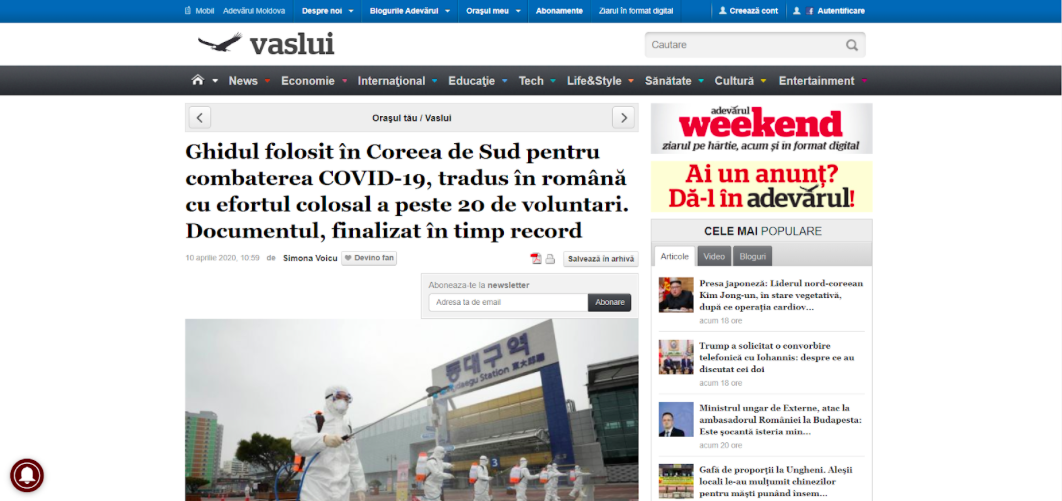
News report about Margarint’s project (in Romanian).
Vlad-Dumitru Margarint, Postdoctoral Fellow of Mathematics at NYU Shanghai initiated and coordinated the translation into Romanian of the South-Korea Guide against SARS-CoV-2. South Korea was one of the first countries to grapple with COVID-19 after China, and the nation’s responses has been lauded as one of the world’s best.
Working with Bayar Ilhan, a Neuroscientist whom Margarint had met at the University of Oxford during his PhD studies, Margarint crowdsourced a team of medics, professional translators, researchers, and lawyers to complete an initial translation of the 75 page document in five days.
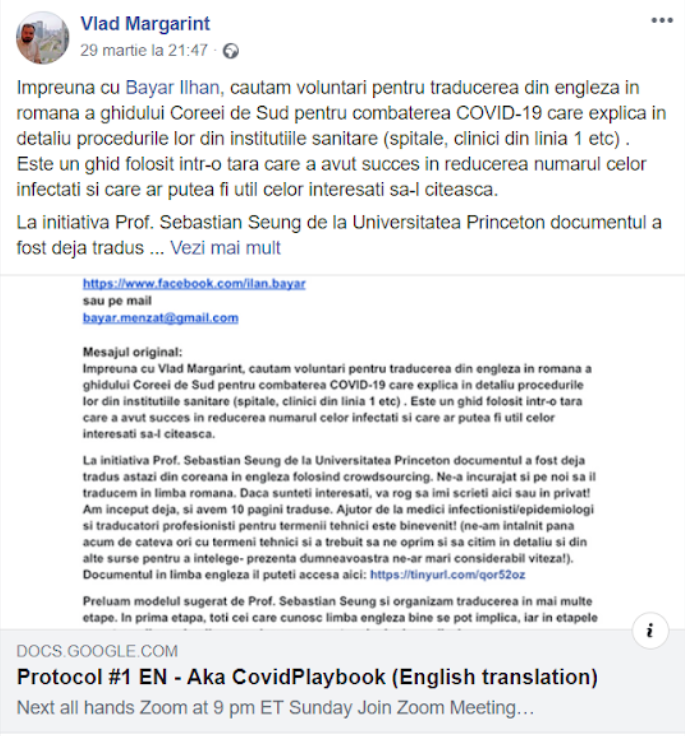
The call for collaborators on Facebook.
The team devoted their time on the weekends and after work hours on weekdays to work on the Romanian version of the guide, which had been initially translated into English through another crowdsourcing effort by Professor Sebastian Seung of Princeton University.
The final version of the guide was completed after another week of consultations with medical and public health professionals and professional translators in order to assure equivalence between the South Korean and Romanian versions.
The initiative was positively received, and the Romanian Minister of Economy, Energy, and Business Environment, Dr. Virgil-Daniel Popescu reached out to the team once he read about the project on social media, and later presented the final document to the Romanian Government.
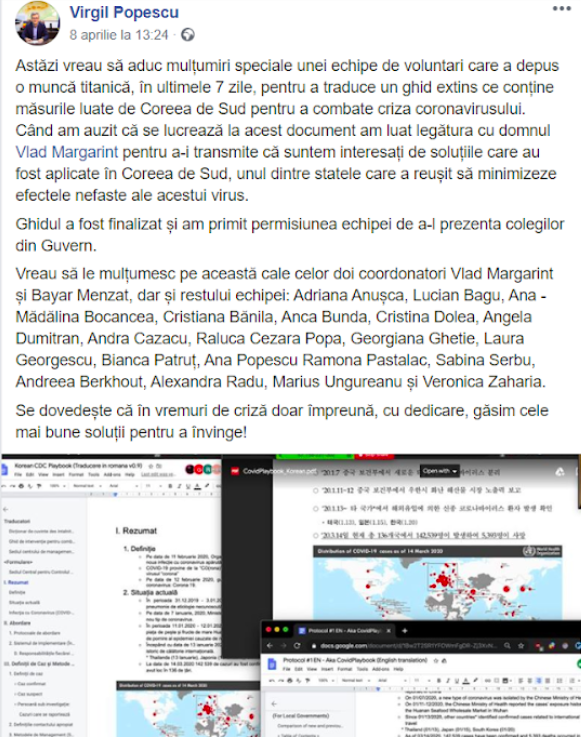
Social media post about the project by Minister Popescu
Margarint and Ilhan’s project was reported about in Romania’s national media and medical newspapers. It was also widely shared among medical professionals in Romania and hospitals throughout the country.
Visit https://www.proiectecovid.org/ to learn more.
Alex Ruthmann: Helping Music Instructors Around the World Transition to Home-based Learning
Alex Ruthmann, Associate Professor of Music Education and Music Technology at NYU Shanghai’s Program on Creativity + Innovation has been working with Assistant Arts Professor Yanyue Yuan to help music instructors around the world put their classes online. The duo have moved their open Creative Learning Meetups online to a webinar format, where they discuss best practices for online teaching for teachers at a variety of education levels (find recordings of past meetups here). Ruthmann is also currently working with NYU Shanghai, NYU Prague, the Singapore Ministry of Education, and music instructors at Steinway piano.
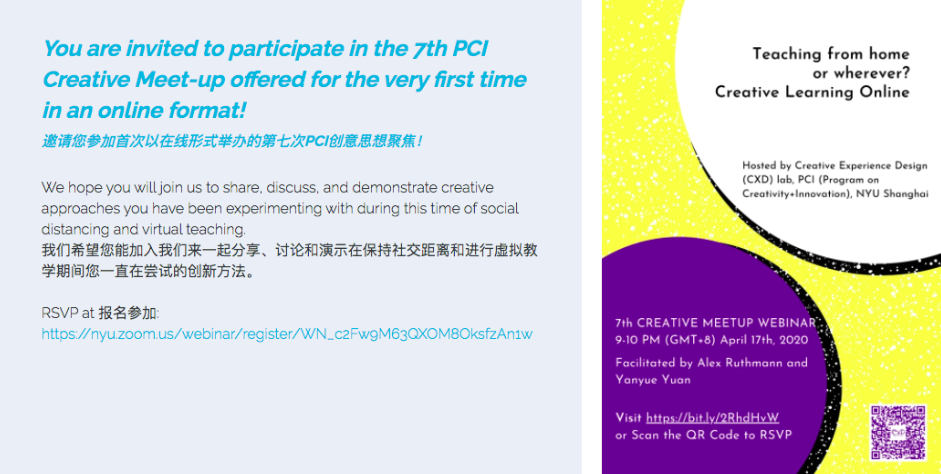
Poster for the April 19th meet-up hosted by Ruthmann and Yuan.
Ruthmann has worked directly with NYU Prague and NYU Shanghai music instructors to translate the live performance aspect of music classes to an online format based on the exchange of short videos between teachers and students. “Music teachers have had to become expert video editors, assembling videos, images, and audio recordings for their videos,” Ruthmann reported.
As part of his year-long virtual appointment as Outstanding Educator in Residence with the Singapore Ministry of Education, Ruthmann is hosting Zoom workshops on individualizing digital tool use for Singapore’s music educators, helping them to design classes that make students’ creative processes visible and shareable with classmates and teachers.
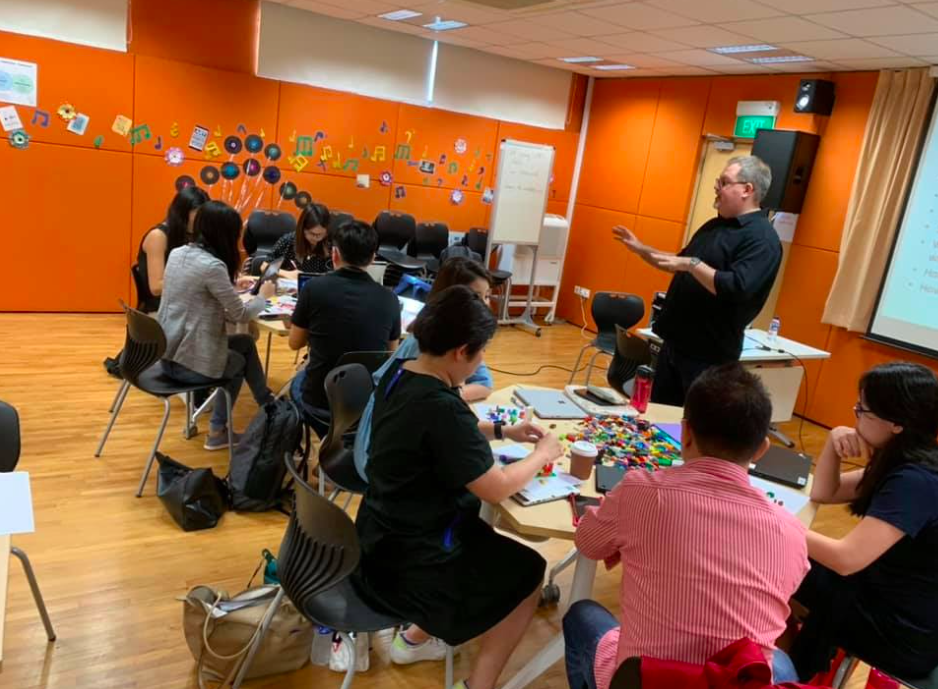
Ruthmann at a live workshop in Singapore in January 2020.
At Steinway, Ruthmann is working with piano teachers to help them optimize distance learning platforms (which are often designed to work with human speech) for musical sounds. He also guides them through ways of connecting multiple cameras so students can see their piano teacher’s hands and face. He has also helped teachers find ways to make the most of students’ shortened attention spans That has also meant encouraging students to create music in non-traditional ways, such as through the many creative music making apps and programs Ruthmann helped develop through the NYU Music Experience Design (MusED) Lab.
Ruthmann and Assistant Arts Professor of Interactive Media Business Yanyue Yuan have begun a Creative Learning Webinar series and research study focused on how NYU global network faculty are responding to the need to conduct courses online. They will study how the online teaching experiences of higher education faculty in Spring 2019 inform their face-to-face teaching approaches in Fall 2020.
Christian Grewell: Apps and Wearables to Slow the Spread of Infection
Assistant Arts Professor of Interactive Media Arts and Associate Director of the Program on Creativity + Innovation and IMA/IMB Christian Grewell is working with Microsoft’s advanced hardware research group in Shenzhen to create a smart bracelet that prevents face touching and an Apple Watch and Android Wear app that promotes effective hand washing. He is also collaborating with fellow researchers and developers from NYU Abu Dhabi on an app that will warn users when they are within six feet of another person.
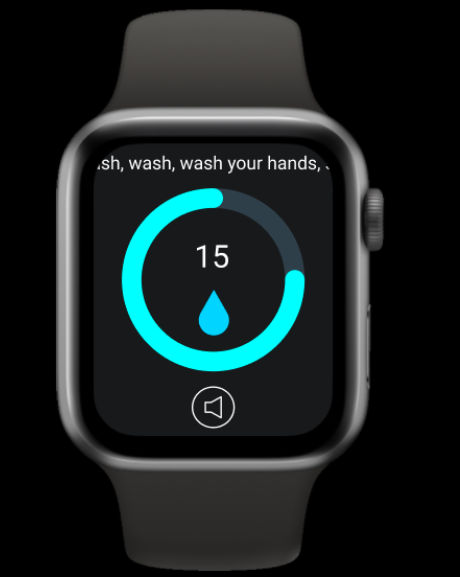
A prototype of the interface for Grewell and Microsoft’s smart watch app to encourage effective hand washing.
The smart bracelet recognizes when its wearer is washing their hands and plays a 20-second jingle, encouraging the wearer to wash their hands for the full extent of the tune in order to thoroughly break down and wash away any SARS-COV-2 cells. In contrast, the smart watch app lets off a warning tone when it detects that its wearer is about to touch their face, potentially allowing viral cells to enter the body through mouth, nose, eyes, or any small abrasions on the skin.
Both use basic machine learning algorithms to learn the patterns of their wearers’ motions and behavior, making them vastly more effective than simple motion-sensing devices.
Although social distancing measures and international travel restrictions have slowed development of the devices, prototypes are already in production. Grewell believes his teams’ devices and apps will be ready for consumers in time to prevent a resurgence of the virus in late 2020.
Read more about Grewell's research in NYU Shanghai Faculty Research Seeks Solutions for Post-COVID-19 World.
Wang Jing: Documenting Xenophobia to Promote Unity
Global Perspectives on Society Teaching Fellow Wang Jing and Li Li, a PhD student in archaeology at Germany’s University of Tubingen, have created the Sinophobia Tracker, an online archive that documents and analyzes racist discourse about the coronavirus. The tracker includes Sinophobic memes, conspiracy-touting editorials, and firsthand accounts of discrimination posted on social media by people of East Asian descent.
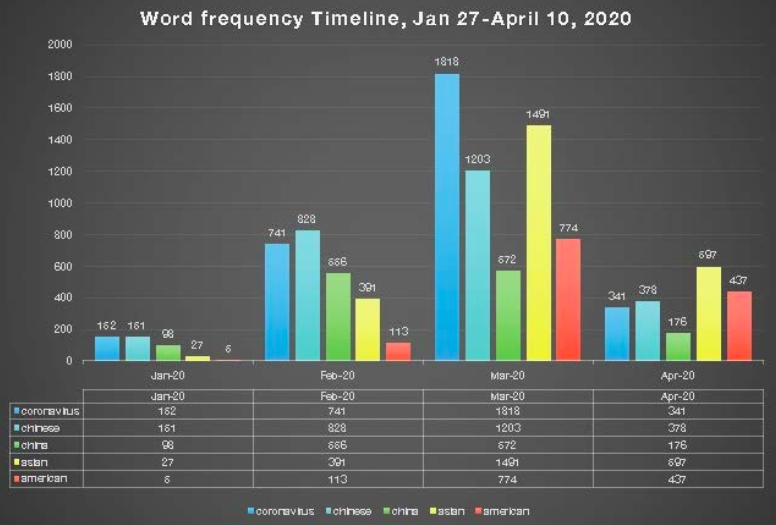
The results of Wang and Li’s word frequency analysis of content documented on their Sinophobia Tracker.
The Sinophobia Tracker project will form the core of a new interdisciplinary course designed by Wang, called “Pandemics and Race,” which will examine the intersection of public health systems with race- and culture-related discourse. In addition, the project will also form a central part of a new program on race, xenophobia, and public health to be developed in concert with Student Diversity programs at NYU Shanghai.

The logo for anti-Sinophobia activist Instagram account @ChineseAgainstRacistVirus, which is featured frequently in the Sinophobia Tracker.
Read more about Wang's work in NYU Shanghai Faculty Research Seeks Solutions for Post-COVID-19 World
Sun Xiang: Molecular Simulations for COVID-19 Drug Discovery
Screening candidate drug molecules systematically and efficiently is one of the biggest challenges for finding a drug to treat COVID-19. Assistant Professor of Chemistry Sun Xiang and his collaborators are working on computational simulations which could help speed up the process.
“My group is currently employing molecular dynamics simulations in combination with a newly developed reaction rate theory to screen out drug candidates that could bind to the spike protein of COVID-19 better than human ACE2 receptor,” says Sun. Finding such a drug would help prevent the spread of the virus because it would inhibit the virus from binding to human cells.
Rather than discovering a drug for COVID-19 directly, Sun hopes that their research will be able to provide guidance for COVID-19 drug discovery, and answer the questions of “if and especially how fast a drug molecule could bind to the virus.”
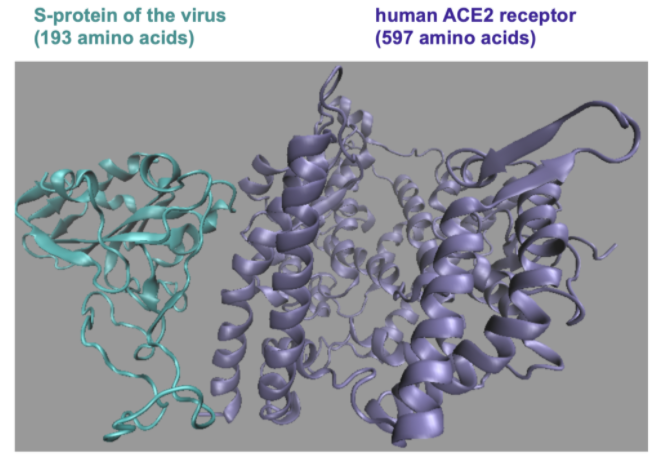
A snapshot of the spike protein of COVID-19 binding with the human ACE2 receptor taken from a molecular dynamics simulation (Credit: Zhengqing Tong, a postdoctoral researcher on Sun’s team)
To follow Sun’s research, see his blog. To read more about this project, read NYU Shanghai Faculty Research Seeks Solutions for Post-COVID-19 World.
Liu Jialin: Examining COVID-19 Transmission in Mega Cities in the US and China Using Machine Learning Algorithms
On a team of researchers led by Assistant Professor of Urban Science and Policy, Guan Chenghe, Postdoctoral Fellow of Urban Ecology, Liu Jialin is using sentiment analysis and machine learning algorithms to examine and predict the spread of COVID-19 in multiple high-risks cities around the world.
The team is examining time series public sentiment dynamics under COVID-19 spread based on social media data such as Twitter and Weibo in the US and China. They will also quantify how regulations and curbs on urban mobility and the impact of climate on COVID-19 transmission in two countries.
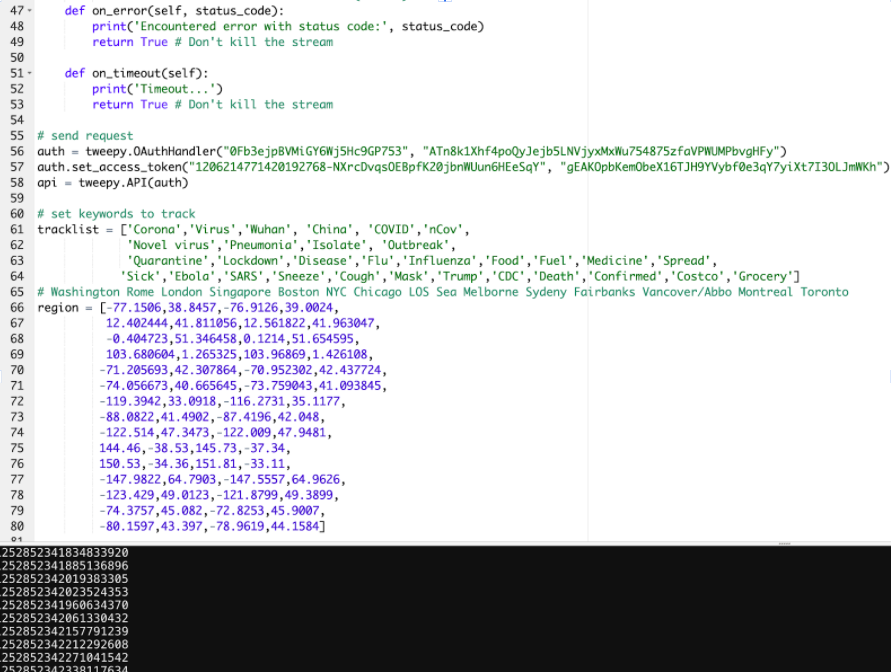
Liu’s algorithm at work
Furthermore, these above mentioned modules will be integrated into a novel machine learning algorithm to monitor the real-time Tweets and Weibo posts, in order to predict high-risk events and areas that may be related to the spread of the virus at its early stage.
The study will expand understanding on how social media outlets reflect and reshape attitudes bearing on COVID-19 outcomes. It will also contribute to and predict how individuals and communities respond to public health emergencies in the future.
The project is still on-going because the global coronavirus situation is changing rapidly. Liu Jialin deployed an online server at the end of February, which has been collecting Tweets and Weibo posts from the virus centers.
“In the beginning, there was only one epidemic center, Wuhan,” says Liu. “But recently, we’ve had to focus on 10+ pandemic centers across Asia, the EU, and North America. We are also extending our networks to Africa and India…. The project has already recorded tens of millions of Tweets and Weibo posts”
This project is supervised by Liu Jialin and prepared by undergraduate research assistant Yao Zhirui ’20.
Volatility Institute: COVID-19 Tracking and Case Study Page
The Volatility Institute has created a page to track the status of the spread of the virus, and financial and economic stress indicators.

Confirmed cases/deaths by country map
The page shows spread of confirmed cases or confirmed deaths throughout the globe, as well as the relative volatility of countries around the world. Users can check the relative volatility of major markets for each country as well as the number of confirmed cases and deaths for that country. It is possible to view volatility, confirmed cases, and deaths by country and by date, and users can also hover over an “events” counter at the bottom of the map to see news published about the virus on a specific date.
The page also features a Confirmed Cases by Country chart, a Diffusion of Confirmed Cases Per 10 Million People by Country chart, and a Risk Data Time Series chart. The Risk Data chart allows the user to plot various financial and economic risk measures against each other, as well as the number of COVID-19 confirmed cases and deaths.
Claire Whitenack: A Visual Archive of Public Health Messaging Related to COVID-19
Lecturer, Claire Whitenack, is compiling a visual archive of public health messaging related to COVID-19 as encountered by NYU faculty and students around the world. Whitenack is hoping that the archive will facilitate conversations about effective health communication in public places, and that it will allow future students to look back at the messaging about the virus that current students, faculty members, and staff are encountering this semester wherever they happen to be. In order to build the archive, she is asking interested students, faculty, and staff to send photos of health messaging about the outbreak. Instructions below:
-
Take a photo of a public poster, sign, flyer, floor sticker, and other messaging about the coronavirus outbreak. Don’t violate a lockdown or otherwise put your safety at risk!
-
Attach it to an email and describe the city, province/state, and country where you took the photo. Note that I will give you credit for the photo using the name attached to your email address.
-
Add a rough translation into English (helpful but optional) and any other information you’d like people to know about the location—e.g. “I found this in the supermarket.”
-
Send to the dedicated email address: covidarchive19@gmail.com.
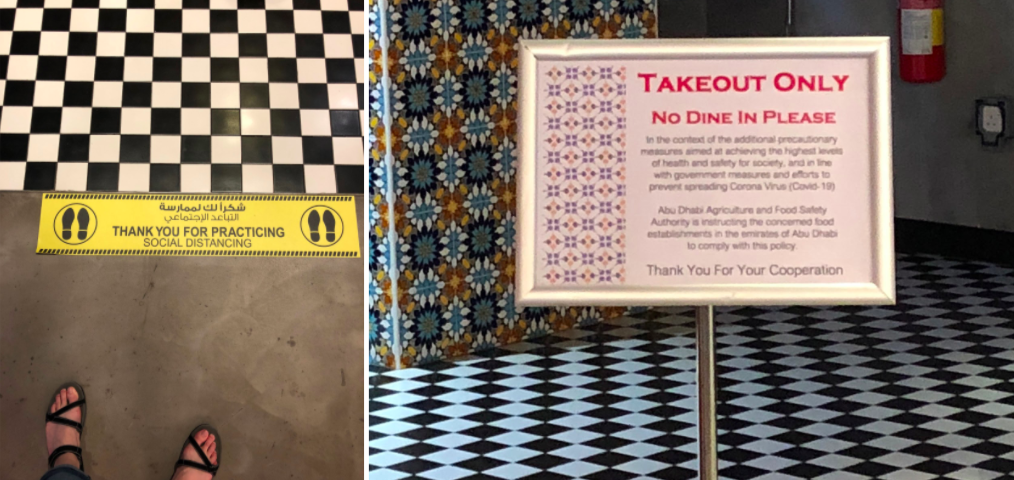
Signs at the NYU Abu Dhabi campus.
David Yu: Recent Work, Published Articles, Editorials, and Interviews
Below is a summary of Assistant Professor of Practice in Finance David Yu’s recent work, which has been published in the Nikkei Asian Review, the Financial Times, South China Morning Post, Forbes, and Australian Broadcasting Corporation.
Articles and Op-Eds
Asian airlines need government support now as situation spirals -- Nikkei Asian Review
Coronavirus threatens to push Asian airlines into bankruptcy -- Nikkei Asian Review
Coronavirus will be a Drag on Global Connectivity and Cross-Border Investments -- Forbes
How have Public Aircraft Leasing Companies Performed? -- KPMG Ireland
New Underlying Trends in Chinese Cross-Border Investments -- JHU Applied Economics Institute, Studies in Applied Economics No. 145
Accounting for Sustainability: Current and Future Impacts of ESG Frameworks on Aviation Investments -- Airline Economics Feb - March 2020
Aviation M&A Trends -- Airline Economics Leasing & Finance Guide 2020
Chinese leasing market is entering a new chapter: Increased activity in Chinese lessor portfolio churn is well timed amid upcoming consolidation -- Airfinance Journal
Print & Radio Media Interviews
New Air Travel Health Regulations Will Likely Stick Around Post-Coronavirus -- Conde Nast Traveler
Cathay Pacific parks half its fleet and slashes nearly three-quarters of March flights as coronavirus epidemic hammers global aviation industry -- South China Morning Post
Hong Kong Airlines to axe 400 jobs as coronavirus adds to financial crisis at troubled carrier -- South China Morning Post
HNA Group’s Asset Sales to Prioritize Creditors Over Core Business -- Forbes
Cathay Pacific expects first-half loss as coronavirus hits demand -- Financial Times
Airlines feeling economic brunt of coronavirus -- ABC News (Australian Broadcasting Corporation)
As airlines face an economic hit from COVID-19, passengers are told it's safe to keep flying -- ABC News (Australian Broadcasting Corporation)
How is COVID19 affecting the Aviation Industry? -- BFM 89.9 Radio's Evening Edition show
New Bid Made For Malaysia Airlines -- BFM 89.9 Radio's Evening Edition show
Impact of COVID19 on Airlines -- CNA 938 Radio's Singapore Today show -
Coronavirus Effects on Airlines Globally -- ARD German Radio
ANALYSIS: Asian airlines negotiate on lease rent amid coronavirus -- Cirium
Marti G. Subrahmanyam: Saving the EU from Economic Collapse
As social distancing measures and stay-at-home orders have rolled out in cities across the world, millions of businesses have seen their operations grind to a halt and revenue streams slow to a trickle. Along with research colleagues throughout Europe, Marti G. Subrahmanyam, NYU Shanghai Global Network Professor of Finance and Economics and Charles E. Merrill Professor of Finance, Economics, and International Business at NYU Stern School of Business, is trying to make sure that this worldwide economic slowdown doesn’t turn into a tidal wave of bankruptcies and permanent business closures in the European Union.
“The virus and its economic effects have no precedent in living memory. It is fair to say that never before in human history has there been a common cause for concern that affects literally every citizen of the world at the same time,” Subrahmanyam says. He and his research group have therefore proposed the creation of an unprecedented pan-European equity fund financed by the European Investment Bank (EIB), and ultimately the European Union, to support a balanced recovery throughout the EU.
In an editorial published April 9thon Bloomberg.com, Subrahmanyam and his colleagues argue that their proposal is the only way to preserve the European dream of a common economic zone. Without a highly organized effort to support financially stressed companies regardless of where in Europe they are headquartered, the group believes that companies from fiscally stressed countries like Italy and Spain will be unable to compete against companies from stronger economies like Germany, completely razing the “level playing field” that the European project was designed to create.
Subrahmanyam’s proposal and detailed guidelines for implementation have been published by several business and policy journals and international news media, and the plan has already captured the attention of EU policymakers eager to find solutions to the impending economic disaster. Officials from the European Commission, the European Central Bank, finance ministries in several countries, and national central banks such as the Bank of England and the Bank of Portugal have contacted the researchers to learn more about the details of their proposal.
Vox EU: “The Coronavirus and Financial Stability,” “Coronavirus and Financial Stability 2.0: Act Jointly Now, But Also Think About Tomorrow,” “Coronavirus and Financial Stability 3.0: Try equity – Risk Sharing for Companies, Large and Small”
Bloomberg: “How to Rebuild After the Crisis”
Frankfurter Allgemeine Zeitung: “Ein Eigenkapitalfonds für Europa und seine Unternehmen”
Business Times (Singapore): “The Case for State-Owned Equity: Saving Singapore SMEs”
The Hill: “Insider Trading by Congress? It’s Time to Fix the Law”


